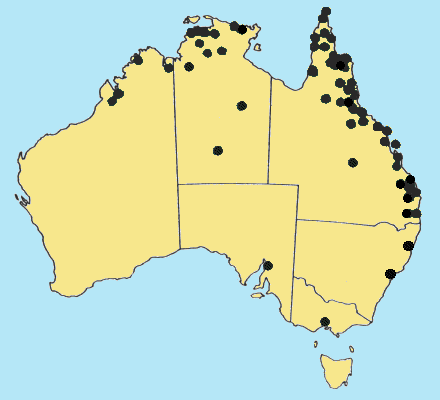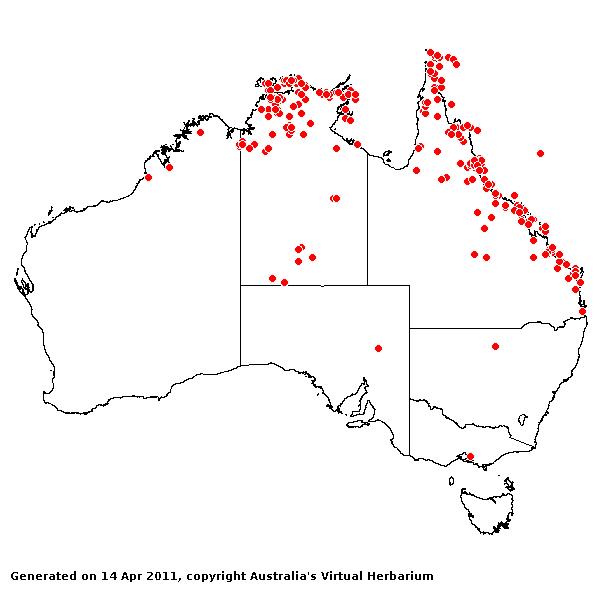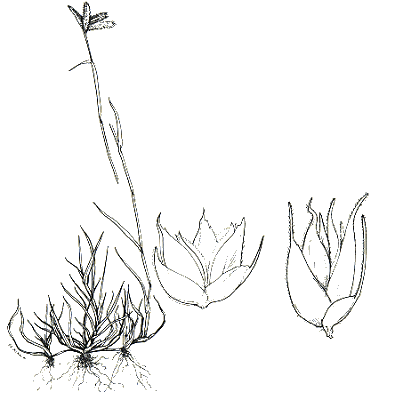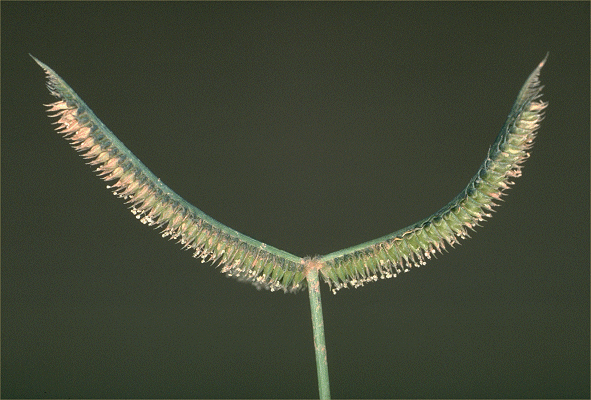Dactyloctenium aegyptium* (L.) Willd. Enum.
Hort. Berol. 1029 (1809).
Classification. (GPWG 2001) : Subfamily
Chloridoideae. Cynodonteae.
Basionym and/or
Replacement Name: Cynosurus
aegyptius L., Sp. Pl.
1: 72 (1753).
Type of Basionym or
Protologue Information: Habitat in Africa, Asia, America. LT: van Royen s.n.,
(L).
Key references
(books and floras): [1878] G.Bentham, Flora Australiensis 7 (615 as Eleusine
aegyptiaca), [1969] E.E.Henty, Manual Grasses New Guinea
(60), [2002] D.Sharp & B.K.Simon, AusGrass, Grasses of Australia,
[2008] S.W.L.Jacobs, R.D.B.Walley & D.J.B.Wheeler, Grasses of New South
Wales (195).
Illustrations:
[2005] K.Mallet (ed.), Flora of Australia 44B: Poaceae 3
(Fig. 55F-G), [2008] S.W.L.Jacobs, R.D.B.Whalley & D.J.B.Wheeler, Grasses
of New South Wales, 4th edn (195).
Habit. Annual
or perennial. Rhizomes absent. Stolons present. Culms geniculately ascending or
decumbent or prostrate, 5–100 cm tall. Ligule a fringed membrane, a ciliolate
membrane or a ciliate membrane, 1 mm long. Leaf-blades 3–25 cm long, 2.5–7.5 mm
wide.
Inflorescence.
Inflorescence digitate, with spicate branches. Rhachis deciduous from axis.
Spikelets.
Spikelets sessile. Fertile spikelets many flowered, with at least 2 fertile
florets (2–4), comprising 2–4 fertile floret(s), with diminished florets at the
apex, elliptic or oblong or ovate, laterally compressed, 2.5–4.5 mm long.
Glumes. Glumes
dissimilar. Lower glume ovate, keeled, 1-keeled, 1 -nerved. Lower glume apex
muticous or mucronate. Upper glume elliptic or oblong, 1.5–2.2 mm long,
membranous, keeled, 1-keeled, 1 -nerved. Upper glume apex awned.
Florets.
Fertile lemma 2.5–4 mm long, keeled, 3 -nerved. Lemma apex muticous or
mucronate. Palea 2 -nerved. Anthers 3. Grain 1 mm long.
Continental
Distribution: Europe, Africa, Temperate Asia, Tropical Asia, Australasia,
Pacific, North America, and South America.
Australian
Distribution: Western Australia, Northern Territory, South Australia,
Queensland, New South
Wales, Christmas Is, Cocos Keeling Is, Ashmore Reef, Coral Sea Is.
Western
Australia: Gardner.
Northern Territory:
Darwin & Gulf, Barkly Tableland. South
Australia: Northern Lofty. Queensland:
Cook, Leichhardt, Mitchell, Moreton, North Kennedy, Port Curtis, South Kennedy,
Wide Bay. New South
Wales: North Coast, Central
Coast.
Notes.
As well as its value as a sand stabiliser, D. aegyptium is considered
useful as pasture in some areas, and persists under grazing, but is reported
(from overseas) to be rich in cyanogenetic glycosides and therefore a danger to
stock at certain times.
Previously described as an annual, D.
aegyptium frequently assumes a perennial, stoloniferous habit in Australia, and
has been confused with the perennial D. australe. However, D.
aegyptium is distinguished by the much shorter anthers and shorter rachis
prolongation, with usually a greater number of spikes and abaxial side of leaf
blades usually hairy from the base. It differs from the Australian endemic D.
radulans in having a globoid rather than plano-convex or ellipsoid
caryopsis, spikes usually longer and free from each other except at the base,
and a taller habit.
Introduced;
occurs mostly within 200 km of the eastern coast of Qld, from Brisbane to
northern Cape York, in the northern part of the N.T. and within 100 km of the
coast in the Kimberley region of W.A., but also reported from settled inland
areas of the N.T. and Qld. Planted as a sand stabilizer in N.T. and coastal
N.S.W. and persistent in some of these areas; A pan-tropical weed, distributed
throughout the Old World Tropics, probably originating in Africa, and
introduced into America. Most common in disturbed areas but also present in
open Eucalyptus forest on a variety of soils, and on coastal dunes;
flowers Jan.-Apr.




